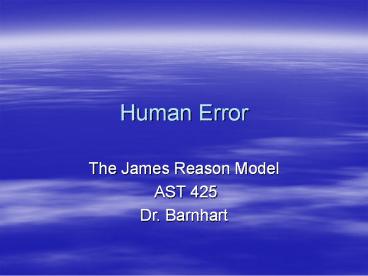Human Error PowerPoint PPT Presentation
Title: Human Error
1
Human Error
- The James Reason Model
- AST 425
- Dr. Barnhart
2
Human Error
- Human Error study is still in its infancy- much
we still dont understand - Human error in technology breakdown has increased
fourfold in 30 years- consequences are
increasingly dire
3
Definitions
- Accident or Event Trajectory
- Defenses, Barriers, and Safeguards- vary from few
to many- from heavily defended to lightly - Unsafe acts- errors and violations
- Latent failure- On the Blunt End
- Active Failure- On the Sharpend
- Local Trigger- Trips the Event
- Event- Complete Penetration of a trajectory- have
varying natures from all active (possibly Egypt
Air 990 to all latent Columbia- 1st shuttle
disaster)
4
Error
- The term human error as used herein is composed
of two components - -Error Factors- unintended
- - Violations- intentional
5
Errors
- True errors occur within the mind of an
individual and derive mainly from informational
problems (forgetting, inattention, incomplete
knowledge).
6
Violations
- Violations- occur within a social context and are
largely motivational problems such as poor
morale, failure to reward compliance and/or
sanction Non-compliance
7
Individual or Collective errors?
- The issue of whether accidents are individually
caused or collectively caused revolves around
three dimensions - Moral
- Scientific
- Practical
8
Moral Issue- much to be gained
- Easier to pin legal responsibility on
individuals- more direct connection - Issue compounded by professionals willing to
accept responsibility- (captain etc.) - Most people highly value personal autonomy- they
should have known better - We assume big failures result from big mistakes
rather than several small ones - Emotional satisfaction in blaming someone
9
The Scientific Dimension- do we stop with people
directly involved or go on back?
- Why stop at organizational roots? Why not go back
to the beginning of creation? - Answer should be practical- go back so far as to
be able to change organizational behavior - Peculiar nature of accidents- initially appear to
be the convergence of many failures but we would
see the same in any organization frozen in time-
why then are failures rare?
10
What then about the practical?
- Moral issue- favors individual approach
- Scientific issue- undecided
- Answer here depends on two factors
- can latent factors be identified and stopped
prior to an accident? - The degree to which improvements can better equip
the organization to deal with local failures
11
Categories of errors and violations
- Errors and violations can be categorized into
three areas - Skill based
- Rule based
- Knowledge based
12
Errors
- Basically there are three types of skill based
errors - Attentional slips- failure to monitor progress of
routine actions at some critical point - Memory lapses- forgetfulness (most common)
- Perceptual error- misrecognition of some object
we see what we expect to see - Most slips and lapses have minimal consequences
responding fine to hello etc. but on the
flight deck they can be dire!
13
Rule Based Mistakes
- Two types
- Misapplication of good rules- braking to avoid a
deer on an icy road we humans tend to apply
solutions to familiar problems on the basis of
largely automatic pattern matching - Application of bad rules- learning shortcuts and
cutting corners- usually circumstances are
forgiving and you get by with it
14
Knowledge based mistakes
- Due to Limited capacity of working memory
- Incomplete mental models of the problem
- Thinking on ones feet- confirmation bias-
bending the facts to fit a hasty conclusion,
over-confidence, similarity bias, and frequency
bias
15
Skill-based violations
- Corner cutting promoted by a largely indifferent
environment
16
Rule-based violations
- More deliberate than skill based violations
17
Knowledge based violations
- Novel circumstance- no specified procedure
- Trainers and procedure writers can only address
the foreseeable - Usually involve the unexpected occurrence of a
rare but trained for situation or an unlikely
combination of individually familiar circumstances
18
To Finish Defining Error
- Cicero stated- To err is human
- Accidents result from a failure of the risk
management system to absorb the consequences of
these errors (unsafe acts) - Human error is stubborn sophisticated discrete
solutions to human error will likely lead to more
sophisticated sources of error- we must be
prepared to manage it
19
The End
- Questions?

